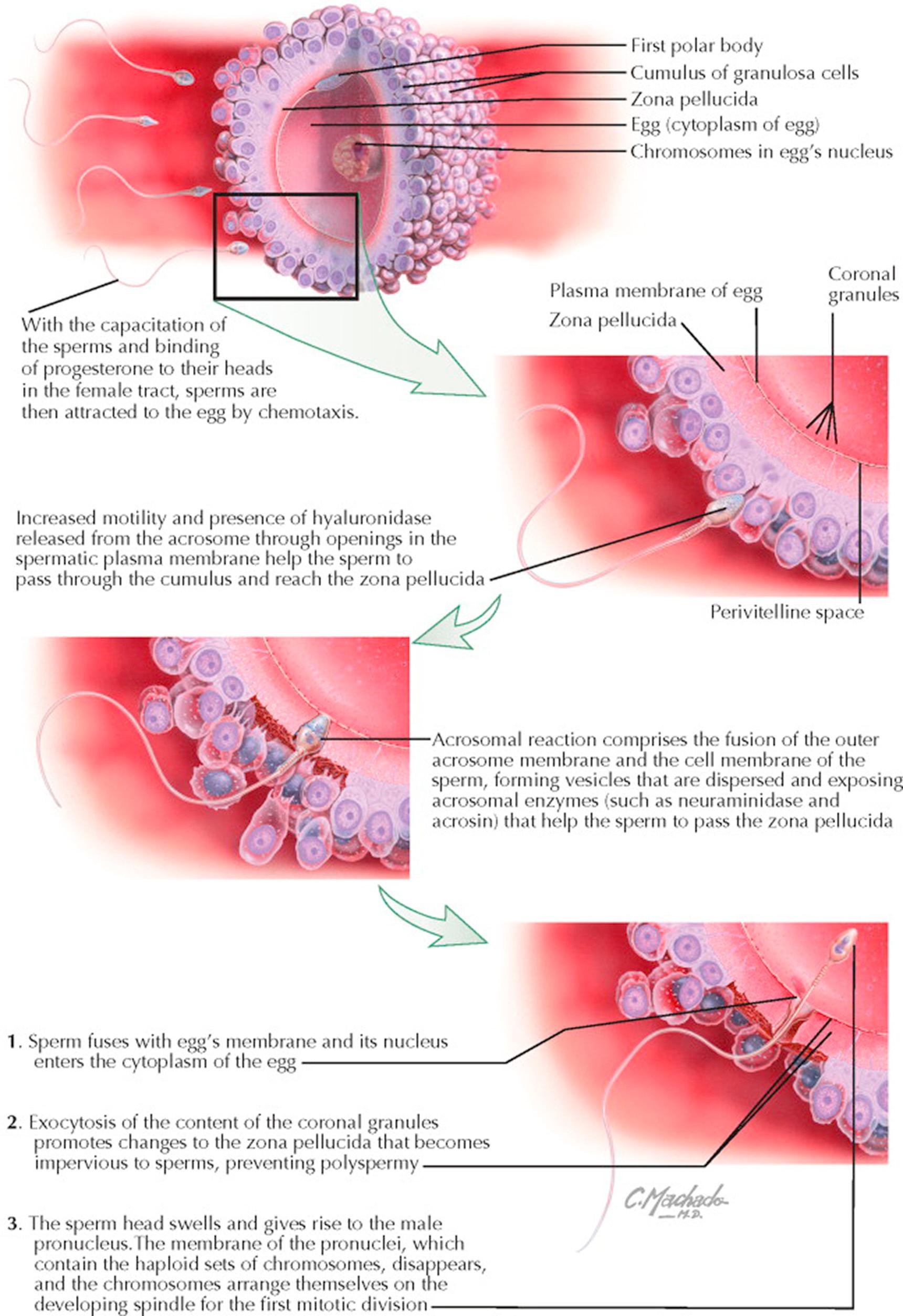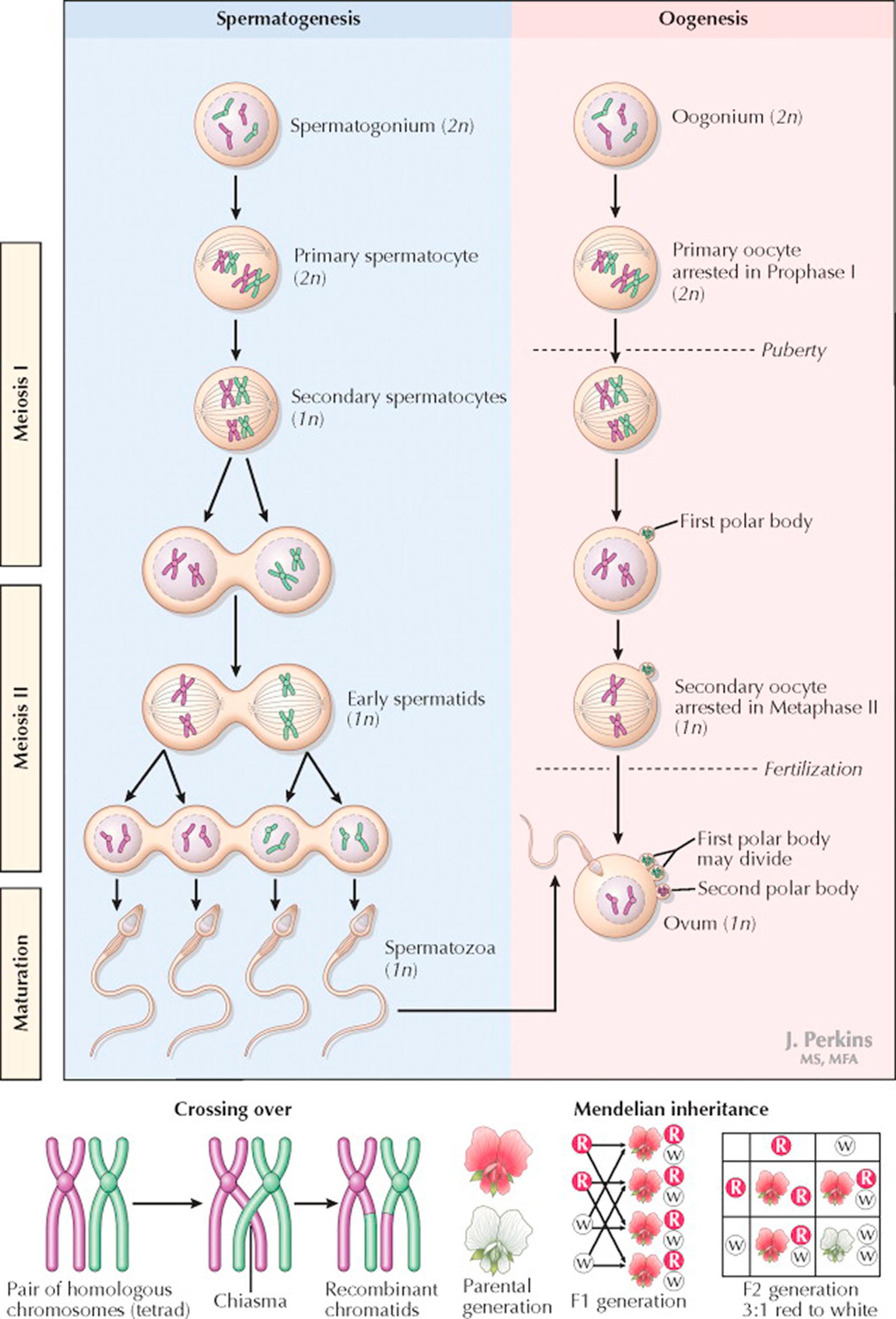Physical Address
304 North Cardinal St.
Dorchester Center, MA 02124
The completion of the final steps of meiosis I and the release of the oocyte from the parenchyma of the ovary constitute the process of ovulation. Through a process that takes approximately 375 days (13 menstrual cycles) a number of dormant, undeveloped primordial follicles begin to grow. These develop in a complex process of bidirectional hormonal feedback that results in the selection of one (or occasionally more than one) dominant follicle. (Advancing maternal age is associated with a higher frequency of multiple egg release with ovulation.) The preovulatory follicle (mature graafian follicle) contains an oocyte arrested in prophase of meiosis I. This is surrounded by a layer (corona radiata) of granulosa cells, a layer of mural granulosa cells, a protective basal lamina, and a network of blood-carrying capillary vessels sandwiched between a layer of theca interna and theca externa cells. A large collection of fluid, occupying the antrum, predominates in the follicle. These growing follicles are surrounded by granulosa cells, which engage in bidirectional messaging with the theca cells and the oocyte to facilitate follicular function. A dominant follicle is established by day 5 to 7 of the cycle.
Just prior to ovulation, the oocyte resumes meiosis, approaching completion of its reduction division. (Meiosis will not be completed until after a sperm has entered the egg and the second polar body is expelled.) During the preovulation phase, the granulosa cells of the follicle enlarge and acquire lipid inclusions, and the theca layer develops a rich vascular supply while the cells undergo vacuolization. There is also a transfer of inhibin production to LH control, ensuring continued function as FSH levels drop.
Ovulation occurs because of a rapid increase in the follicular fluid and the direct action of proteolytic enzymes and prostaglandins. Follicular fluid accumulates gradually as the follicle grows but rapidly increases to 1 to 3 mL in response to the LH surge and a change in follicular wall elasticity. In addition, the theca cells surrounding the follicle begin to erode through the overlying epithelial covering of the ovary with the help of proteases, collagenase, plasmin, and prostaglandins E 2 , F 2α , and other eicosanoids. These weaken the capsule and stimulate smooth muscle contractions in the cortex of the ovary, facilitating rupture of the follicle and the expulsion of the egg. The LH surge, by itself, is inadequate to induce ovulation in a follicle that has not undergone sufficient maturation. Once the oocyte has been released from the follicle, it is picked up by the fimbria of the fallopian tube for transport to the uterus, whether it becomes fertilized or not.
The remnant of the follicle, with its LH sensitized (luteinized) granulosa cells, is the corpus luteum, and is responsible for continued hormone production. There is a proliferation of the luteinized granulosa cells to fill the cavity. The corpus luteum reaches maximum production of estrogen and progesterone at about 10 days after ovulation. If conception has not occurred, the corpus luteum begins to regress, ending its function by about 14 to 15 days after ovulation. The exact reason for this involution is unknown, but only rescue by human chorionic gonadotropin (hCG) can prevent its occurrence.
It is the continued production of estrogen, progesterone, and inhibin that suppresses the hypothalamus, decreasing its gonadotropin-releasing hormone production. This, in turn, decreases the release of FSH and LH from the pituitary, further preventing other follicles from maturing and releasing their eggs. This self-limiting process generally ensures that there is only one egg, which can be fertilized each month. Failure of this system to inhibit additional follicles, or the near simultaneous rupture of more than one follicle, can set the stage for fraternal twinning.

The union of sperm and egg constitutes fertilization. The apparent simplicity and frequency of this phenomenon belie the complexity of the process. For fertilization to be accomplished, appropriate maturation of an oocyte in a dominant follicle must occur, ovulation must successfully release the egg, and sperm capable of fertilization must be present in adequate numbers. Even all of these events are not sufficient to accomplish either fertilization or pregnancy.
Following ovulation, the egg is picked up by the fimbrial end of the fallopian tube for transport to the uterine cavity. When the egg enters the fallopian tube, it is surrounded by a cumulus of granulosa cells and intimately surrounded by a clear zona pellucida. Within the zona pellucida are both the egg (in metaphase II stage) and the first polar body. Meanwhile, spermatozoa are transported through the cervical mucus and the uterus and into the fallopian tubes. During this transport period, the sperm undergo two changes: capacitation and acrosome reaction. These changes activate enzyme systems within the sperm head and make it possible for the sperm to cross the cumulus and the zona pellucida.
Once sperm and egg encounter each other (generally in the ampulla of the fallopian tube), the sperm are attracted to an egg through chemotaxis, made possible by capacitation of the sperm and binding of progesterone to a surface receptor on the sperm. These increase sperm motility, helping them pass the barrier of the cumulus and zona pellucida, where the sperm attaches to the cell membrane of the egg and enters the cytoplasm. When the sperm enters the cytoplasm, intracytoplasmic structures, the coronal granules, arrange themselves in an orderly fashion around the outermost portion of the cytoplasm just beneath the cytoplasmic membrane, and the sperm head swells and gives rise to the male pronucleus. Under this stimulus, the egg completes its second meiotic division, casting off the second polar body to a position also beneath the zona pellucida. The pronuclei, which contain the haploid sets of chromosomes of maternal and paternal origin, do not fuse, but the nuclear membranes surrounding them disappear, and the chromosomes arrange themselves on the developing spindle for the first mitotic division. In this way, the diploid complement of chromosomes is reestablished, completing the process of fertilization.
Over the course of 20 hours following the attachment of the chromosomes to the spindle, cell division (cleavage) occurs, giving rise to the two-cell embryo. A significant number of fertilized ova do not complete cleavage for a number of reasons, including failure of chromosome arrangement on the spindle, specific gene defects that prevent the formation of the spindle, and environmental factors.
Over the course of 3 to 4 days, the dividing cell mass passes down the fallopian tube toward the endometrial cavity. Early trophoblastic cells formed during the blastula stage of development digest away the zona pellucida to allow the embryo to burrow into the thickened endometrium. Implantation of the embryo generally takes place about 3 days after the embryo enters the uterine cavity. Through most of this process, exposure to toxic agents (teratogens or radiation) is usually either completely destructive or causes little or no effect. Twinning may occur at any time from the two-cell stage until the formation of the blastula just prior to implantation.

Become a Clinical Tree membership for Full access and enjoy Unlimited articles
If you are a member. Log in here